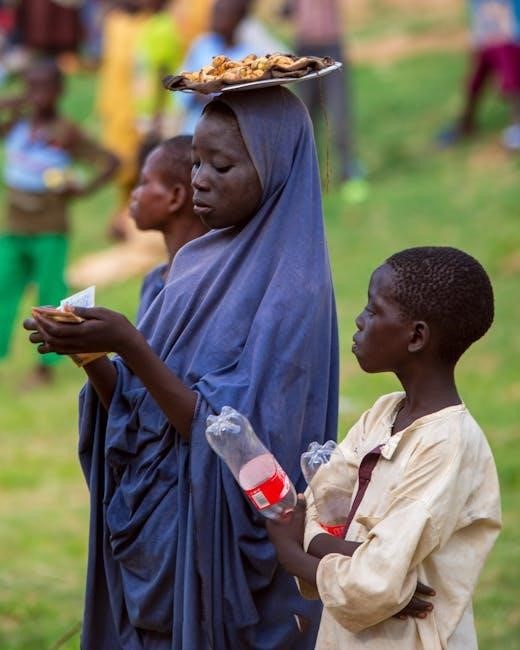Bertolt Brecht’s The Good Woman of Setzuan is a parable exploring virtue, survival, and societal corruption. Set in China, it follows Shen Te’s moral struggles, blending humor and critique. The play, written during Brecht’s exile, reflects his Epic Theatre style, challenging audiences to question ethical dilemmas. Available as a PDF, it remains a vital resource for understanding Brecht’s work and its enduring relevance.
Overview of the Play
The Good Woman of Setzuan is a parable by Bertolt Brecht, set in the Chinese city of Sichuan. It tells the story of Shen Te, a young woman whose kindness is tested by the harsh realities of her society. When three gods arrive in search of a virtuous person, Shen Te’s generosity is rewarded, but her struggles to survive while remaining good lead to moral dilemmas. The play explores themes of virtue, exploitation, and societal corruption, offering a critique of capitalism and human nature. Available as a PDF, it provides a digital gateway to Brecht’s thought-provoking work.
Historical Context and Significance
The Good Woman of Setzuan was written by Bertolt Brecht during his exile in the 1930s, reflecting the political and social turmoil of the time. The play critiques capitalism and societal exploitation, drawing parallels to the rise of fascism in Europe. Its setting in pre-communist China serves as a metaphor for universal human struggles. Brecht’s collaboration with Margarete Steffin and Ruth Berlau shaped its themes of morality and survival, making it a landmark of Epic Theatre. The PDF version preserves this historical masterpiece for modern readers.

Bertolt Brecht: The Playwright
Bertolt Brecht was a 20th-century German playwright who revolutionized theatre with Epic Theatre techniques. His works, like The Good Woman of Setzuan, blend political critique with moral dilemmas, influencing global drama.
Brief Biography and Influence
Born in 1898 in Augsburg, Germany, Bertolt Brecht was a pivotal playwright and poet of the 20th century. His influence on modern theatre is immense, particularly through his development of Epic Theatre. Brecht fled Nazi Germany in the 1930s, continuing his work in exile. His plays, such as The Good Woman of Setzuan, critique societal structures and explore moral complexities. His innovative techniques, like the alienation effect, revolutionized storytelling, leaving a lasting impact on global drama and political art.
Brecht’s Exile and Creative Process
Bertolt Brecht began writing The Good Woman of Setzuan in 1938 while in Denmark, fleeing Nazi Germany. His exile deeply influenced his work, as he grappled with themes of morality and survival. Brecht’s creative process was collaborative, involving Margarete Steffin and Ruth Berlau. The play reflects his Epic Theatre style, aiming to provoke critical thinking. Despite the challenges of exile, Brecht’s innovative approach continued to shape his writing, leaving a legacy of political and social commentary in his plays.

The Plot and Setting
The Good Woman of Setzuan is set in the Chinese city of Sichuan, where Shen Te, a kind-hearted prostitute, faces moral dilemmas amid societal corruption, guided by three indifferent gods.
The Parable of a Virtuous Woman
Bertolt Brecht’s The Good Woman of Setzuan centers on Shen Te, a kind-hearted prostitute in Sichuan, whose virtuous nature is tested by societal greed and corruption. The play explores her internal conflict between maintaining her morality and surviving in a harsh world. As a parable, Shen Te’s story challenges the idea of pure virtue, questioning whether it can exist without compromise. Brecht uses her journey to critique societal structures and provoke reflection on morality, blending humor with profound moral dilemmas.
The City of Sichuan as a Symbolic Backdrop
The city of Sichuan in The Good Woman of Setzuan serves as a symbolic setting, representing a society plagued by corruption and greed. Its vibrant culture contrasts with the moral decay of its inhabitants, highlighting the contradictions of human nature. The city embodies Brecht’s critique of capitalist exploitation and societal hypocrisy. Through Sichuan’s backdrop, Shen Te’s struggle between virtue and survival is amplified, underscoring the play’s universal themes of ethics and societal failure.

Themes and Moral Dilemmas
The play explores virtue versus survival, societal corruption, and divine intervention, questioning morality in a harsh world. Shen Te’s struggle embodies these dilemmas.
Virtue vs. Survival in a Corrupt Society
In The Good Woman of Setzuan, Shen Te embodies the struggle between virtue and survival in a corrupt world. As a kind-hearted prostitute, she navigates societal exploitation, questioning whether goodness can thrive without compromise. Brecht critiques the idea of absolute virtue, highlighting the impossibility of moral purity in a flawed system. The play challenges audiences to consider how societal structures force individuals into ethical dilemmas, making survival often more practical than righteousness.
The Role of the gods in Human Affairs
In The Good Woman of Setzuan, the gods serve as detached observers, initiating the parable of Shen Te’s virtue but offering no tangible aid. Their divine indifference highlights Brecht’s critique of religious intervention in human struggles. The gods’ inaction underscores the play’s central theme: the burden of moral responsibility falls solely on humanity. This mirrors Brecht’s exploration of societal structures and the futility of divine solutions to earthly dilemmas, emphasizing human agency over celestial influence.

The Good Woman of Setzuan as a PDF Resource
The PDF version of The Good Woman of Setzuan is widely available, offering a convenient format for studying Brecht’s parable. It includes contributions from scholars like Kumar and features a revised English version with an introduction by Eric Bentley, published by Grove Press. This digital resource is essential for exploring Brecht’s critique of virtue and survival in a corrupt society, making it a valuable tool for both scholars and casual readers.
Availability and Accessibility of the PDF
The PDF version of The Good Woman of Setzuan is widely accessible across various platforms, including academic databases and online bookstores. It is available through contributors like Kumar and publishers such as Grove Press. The digital format ensures compatibility with multiple devices, making it easy for readers to access. Additionally, the PDF includes a revised English version with an introduction by Eric Bentley, enhancing its educational and scholarly value for those interested in Brecht’s work.
Key Features of the Digital Version
The PDF version of The Good Woman of Setzuan offers enhanced readability with clear formatting and searchable text. It includes a revised English translation by Eric Bentley, providing a faithful interpretation of Brecht’s original work. The digital version also features an introduction that contextualizes the play’s themes and historical significance. Compatible with multiple devices, it ensures accessibility for scholars and readers alike, making it an invaluable resource for studying Brecht’s Epic Theatre techniques and the play’s universal themes.

Production History and Adaptations
The Open Fist Theatre Company presented a reimagined version, blending humor and critique. Student groups like Oakwood Friends School have staged adaptations, showcasing its enduring appeal and versatility.
Notable Stage Productions and Interpretations
The Good Woman of Setzuan has seen numerous notable productions, each offering unique interpretations. The Open Fist Theatre Company presented a reimagined version, combining humor with social critique. The Royal National Theatre’s production highlighted the play’s moral dilemmas. Student-led performances, such as those by Oakwood Friends School, demonstrate its educational value. These adaptations showcase the play’s versatility, allowing audiences to connect with its timeless themes in diverse ways.
Modern Reimaginings of the Play
Modern adaptations of The Good Woman of Setzuan infuse fresh perspectives while preserving Brecht’s core themes. The Open Fist Theatre’s production blended cultural elements, creating a vibrant reinterpretation. Digital stagings and experimental formats have also emerged, making the play accessible to new audiences. These reimaginations highlight the timeless relevance of Brecht’s work, ensuring its continued resonance in contemporary theatre and cultural discourse.

The Relevance of the Play Today
The Good Woman of Setzuan remains a powerful commentary on morality, societal corruption, and human resilience. Its themes of survival and virtue resonate universally, making it a timeless classic. Brecht’s critique of capitalism and exploitation continues to provoke thought, ensuring its relevance in contemporary discussions of inequality and ethics. The play’s universal appeal endures, offering insights into human nature and societal structures.
Universal Themes and Contemporary Resonance
The Good Woman of Setzuan explores universal themes of morality, survival, and societal corruption, resonating deeply with contemporary audiences. Its critique of economic inequality and exploitation remains relevant, offering insights into human resilience. The play’s moral dilemmas, such as balancing virtue with practicality, mirror modern struggles, making it a timeless commentary on human nature. Its enduring relevance ensures continued engagement, with the PDF version allowing readers to explore these themes in a accessible format.
Educational Value for Students and Scholars
The Good Woman of Setzuan offers significant educational value, providing insights into Bertolt Brecht’s Epic Theatre and its critique of societal structures. The PDF version enables students to analyze themes like morality, exploitation, and survival, while scholars can explore Brecht’s theatrical techniques and political commentary. Its accessibility makes it a valuable resource for academic study, fostering deeper understanding of dramatic theory and historical context, ideal for both classroom discussions and independent research.
The Good Woman of Setzuan remains a timeless exploration of moral dilemmas, offering enduring relevance. Its PDF availability ensures accessibility, aiding scholars and readers in understanding Brecht’s profound legacy.
Final Thoughts on the Play’s Impact
Bertolt Brecht’s The Good Woman of Setzuan leaves a lasting impact by challenging audiences to reflect on morality and society. Its exploration of virtue versus survival resonates universally, making it a cornerstone of modern theatre. The play’s themes of ethical dilemmas and societal critique continue to inspire new adaptations and interpretations. As a PDF resource, it remains accessible for study and appreciation, ensuring Brecht’s legacy endures in contemporary discourse.
Encouragement to Explore the PDF Version
Exploring The Good Woman of Setzuan in PDF format offers unparalleled convenience and accessibility. Readers can delve into Brecht’s profound exploration of morality and society with ease, anytime and anywhere. The digital version preserves the play’s original depth while enhancing readability. By downloading the PDF, audiences can highlight, bookmark, and revisit key passages, ensuring a deeper engagement with Brecht’s timeless themes. Embrace this opportunity to connect with a masterpiece of modern theatre in a format tailored for today’s readers.
